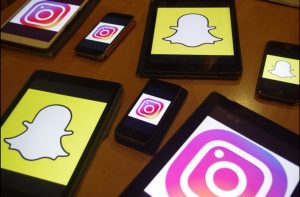Living through a phone screen is being seen as a normal behaviour amongst most youngsters nowadays. It has been identified as a condition in which being addiction to a phone can be called Nomophobia.
Have you ever used the phone photo app Snapchat? The user takes ‘snap’ pictures and sends to others, being viewed for a chosen length of time. It also allows you to keep a ‘snap-story’ where photos are viewed by all followers for 24-hours. This app is suggested as one of the worst culprits for the continual ‘glued-eyes’ on screens when experiencing something such as social scenario, or a new experience.
Other apps such as Instagram have also developed a similar feature on their app, in which a user takes photos which are uploaded in a story style for 24 hours. Alongside the typical features of the app, uploading photographs with captions and hashtags.

These apps having these features of 24 hours ‘day in the life’ style photo/video vlogs have encouraged more people to live an experience through their phone screens and not in face value. Looking through a camera-lens at the world can have an effect on the actual value you take away from it, these abilities to take a vlog style approach to life has been idealised by the famous ‘YouTubers’ that are being encouraged by millions of subscribers on the YouTube site, first created in February, 2005.

With these stylised vlogs having gathered fame throughout the years, these idealised ways of sharing an ‘in the life’ personal video has been adopted by the apps. The satisfaction of watching videos online is by the audiences, avidly following the lives of their YouTuber ‘stars’ on multiple media platforms. So if there was a way to share some of the fame, these apps certainly encourage this behaviour.
The gratification the users of the app Snapchat receive from fellow followers is equal to the popularity achieved by other more popular vlog creators. Do you create stories on either Snapchat or Instagram apps?
Why live through a phone screen?
Do we see the phone screen as a natural filter for our minds to hide behind? It is known that we interact with our phone when we encounter awkward situations. For example when waiting for a friend in a busy location (we’ve all been in that coffee shop, phone scrolling vortex). Even sitting on public transport in London cannot be done without a phone.
Why is it a natural habit to hide? Not only behind the screen but behind the persona that you are trying to mask a certain awkwardness in the first place. What did people do before these technologies were s widely available? Well, they certainly would have been a more social society that is typically and socially allowed to communicate with strangers.

Leave a Reply